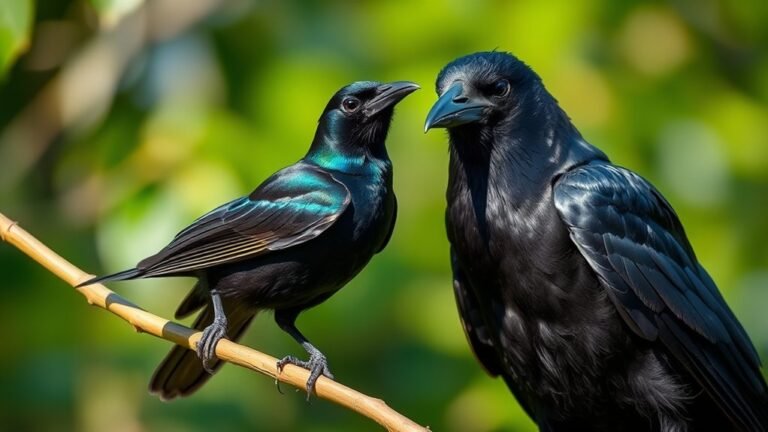Woodpeckers in Maryland: Identification Tips and Facts
In Maryland, you can see different types of woodpeckers. Recognizing their special features can make birdwatching more fun. For example, the Hairy Woodpecker and the Downy Woodpecker are similar, but they are different sizes. Also, the Northern Flicker likes to search for food on the ground. Learning about these birds helps you enjoy them more and supports their protection.
So, what should you look for to tell these birds apart? Pay attention to their size, colors, and how they act. Woodpeckers have unique markings and sounds. Noticing these details can help you spot them more easily. Happy birdwatching!
A Quick Overview
- The Downy Woodpecker is smaller than the Hairy Woodpecker. You can tell them apart by the Downy's short bill.
- Northern Flickers are special because they look for food on the ground and have bright colors in their feathers.
- Male woodpeckers usually have red patches on their heads. This is an important way to identify them.
- Woodpeckers build nests in late winter or early spring. Both parents take care of their baby birds.
- To attract woodpeckers, put up suet feeders, plant native trees, and provide water sources in your yard.
Overview of Woodpecker Species in Maryland

When you visit the forests and parks in Maryland, you can see different types of woodpeckers. Each type has its own special habits and skills. These birds live in many places, including woods and cities, which shows how they can adapt to different environments.
You might spot the Downy woodpecker or the Red-bellied woodpecker—they are common in Maryland. As you watch these birds, pay attention to where they go during different seasons.
Some woodpeckers fly south to find warmer places in winter. This movement helps them find enough food when it gets cold.
Learning about these woodpeckers makes you appreciate Maryland's wildlife more. It helps you feel more connected to the nature around you.
Enjoy watching these fascinating birds!
Common Hairy Woodpecker Characteristics
The Common Hairy Woodpecker is a bird that many people mix up with the Downy woodpecker. However, it has some special features that help you tell them apart. First, the Hairy woodpecker is larger. It grows to about 9 to 10 inches long.
One of the most noticeable things about it is its bill. The bill is longer and stronger, almost the same length as its head. The bird's feathers are mostly black and white. You'll see white on its wings and back, plus a white patch on its neck.
If you look closely at the males, you'll notice they've a small red patch on the back of their heads. Females don't have this red marking.
Identifying the Downy Woodpecker

How can you spot a Downy Woodpecker? It's pretty easy when you know what to look for!
This little woodpecker is about 6 to 7 inches long, making it smaller than its cousin, the Hairy Woodpecker. Pay attention to its colors; the Downy Woodpecker has a white belly and a black back with striking black wings.
One special thing about it is its short, stubby bill. This bill is much shorter than that of the Hairy Woodpecker. If you see a male, look for a small red patch on its head.
When you're out in the woods, listen for its soft drumming sound and call. These sounds can help you confirm you're looking at a Downy Woodpecker.
Knowing these features makes it easier to connect with the woodpecker community in Maryland. Happy birdwatching!
Northern Flicker: A Unique Woodpecker
The Northern Flicker is a special type of woodpecker. Unlike other woodpeckers, it often hunts for food on the ground. This bird has some cool habits and features that make it stand out.
Here are four traits that make the Northern Flicker unique:
- Colorful feathers: It has a spotted chest with a black crescent shape.
- Ground-feeding: You'll often spot it looking for food on the ground, unlike other woodpeckers that peck on trees.
- Wing patterns: When it flies, watch for bright yellow or red colors under its wings.
- Unique call: Its loud call can be heard in the woods.
Pileated Woodpecker: The Giant of the Woods

The Pileated Woodpecker is one of the biggest woodpeckers in North America. You can often find these birds in old forests that have lots of trees. They love to live in areas with both leafy trees and mixed woods.
These woodpeckers have a strong beak that looks like a chisel. They use it to dig big holes in trees to find food, especially carpenter ants. This digging helps them eat and also helps the trees stay healthy by letting natural decay happen. This is good for the whole forest.
If you ever see a Pileated Woodpecker, listen for its loud call. It echoes through the trees and lets you know it's there.
Watching these woodpeckers can help you feel more connected to wildlife in Maryland.
Red-bellied Woodpecker Identification Tips
Let's talk about a cool bird you can find in Maryland: the Red-bellied Woodpecker. Here are some easy ways to spot this interesting bird.
- Look at its looks: The Red-bellied Woodpecker has a black-and-white striped back. It also has a hint of red on its belly, but it's often hard to see.
- Check the size: This woodpecker is medium-sized. It's about 9 to 10 inches long, which is bigger than a sparrow but smaller than a crow.
- Listen for its sound: You might hear a "kwirr" or "churr" noise. This sound is pretty unique and often happens in springtime.
- Where it hangs out: These woodpeckers like different places to live. You can see them in forests or even in your neighborhood. They eat bugs and acorns, which helps them stay healthy.
If you spot a Red-bellied Woodpecker, take a moment to watch it! Observing these birds can help you appreciate Maryland's wildlife even more. Enjoy your birdwatching!
Yellow-bellied Sapsucker: Behavior and Habitat
The Yellow-bellied Sapsucker is an interesting bird. It's a type of woodpecker that lives mainly in temperate forests. This bird likes places with lots of hardwood and softwood trees.
One cool thing about the Yellow-bellied Sapsucker is how it finds food. It makes small holes in trees to get to the sap inside. This sap is very important for this bird, as it's a main source of food. Plus, the sap attracts insects that the sapsucker can eat too!
These birds have specific times when they move around. They usually breed in Canada and the northern U.S. In the fall, they migrate south to Maryland.
Watching a Yellow-bellied Sapsucker is a great way to connect with nature. It helps you appreciate the different birds living in Maryland. Each time you see one, it feels like sharing a special moment with other bird lovers.
Lesser-known Woodpecker Species in Maryland
Have you thought about the woodpecker species that live in Maryland? These birds aren't as famous, but they add to the variety of birds in the state.
Let's explore four woodpeckers you might see:
- Ladder-backed Woodpecker – This bird likes dry areas and can often be found in the western parts of Maryland.
- Acorn Woodpecker – It loves oak trees. This bird likes to store nuts, which is really interesting to watch!
- Nuttall's Woodpecker – You can find this one near rivers and streams. It enjoys being close to water.
- Three-toed Woodpecker – This bird is rare. It prefers to live in pine forests, so spotting one can be exciting!
Each woodpecker has its own special home.
Learning about these birds helps you connect with nature and enjoy birdwatching even more!
Woodpecker Behavior: Pecking and Drumming
Woodpeckers do two main things: pecking and drumming. Each activity has its own purpose. When woodpeckers peck, they search for food. They look for insects hiding under tree bark.
On the other hand, they drum to communicate. You might hear quick, loud beats in the trees. This drumming shows that a woodpecker is marking its territory. It tells other woodpeckers, "This is my space!"
The sounds woodpeckers make can be different, too. Some are short taps, while others are big thuds. Each sound sends a different message.
Learning about these behaviors helps you appreciate how woodpeckers fit into nature. Plus, it makes your time outside in places like Maryland even more exciting!
Nesting and Breeding Habits of Woodpeckers
Woodpeckers are interesting birds! They've bright colors and make unique sounds. Learning about their nesting and breeding habits can be really fun.
Here are some simple facts about how they raise their young:
- Woodpeckers dig out their own nests in dead or rotting trees.
- A mother woodpecker usually lays between 2 and 6 eggs. Both parents take turns keeping the eggs warm until they hatch.
- Most woodpeckers start nesting in late winter or early spring, but this can change based on the type of woodpecker.
- Baby woodpeckers, called fledglings, stay in the nest for about 3 to 4 weeks after they hatch. Then, they're ready to explore outside!
These basic facts show us how woodpeckers begin their families. They work together to care for their eggs and young.
Isn't nature amazing?
Attracting Woodpeckers to Your Backyard
If you want to see and hear woodpeckers in your backyard, you need to make it a friendly place for them.
First, set up woodpecker feeders with suet or peanuts. These tasty snacks will attract woodpeckers. They love high-energy foods, so using nut and seed mixes will help too.
Next, plant some native trees and bushes. These will give woodpeckers a place to hide and build their homes.
Old, dead trees are also great because they provide food for the birds.
Don't forget to add a birdbath or some water, as this can make your yard even more inviting.
By following these simple steps, you'll create a cozy spot for woodpeckers.
Enjoy watching these lively birds as they become a part of your backyard!
Conservation Status and Efforts for Woodpeckers
Many woodpeckers play an important role in our forests.
Sadly, some woodpecker species are in trouble. To help them, we need to know about the threats they face. Here are four key things to keep in mind:
- Deforestation – Cutting down trees takes away the homes woodpeckers need.
- Climate Change – Changes in weather can make it hard for woodpeckers to find food and raise their babies.
- Pesticides – Chemicals used in farming can hurt woodpeckers, either directly or by harming their food sources.
- Urban Development – As cities grow, they can break up areas where woodpeckers live, making it hard for them to survive.
Knowing about these challenges helps you take action.
You can support local programs that protect woodpecker homes. When you get involved, you help create a better place for woodpeckers and other animals too.
Let's work together to keep our forests healthy!
Frequently Asked Questions
What Is the Lifespan of a Woodpecker in Maryland?
The lifespan of a woodpecker can change based on where they live and how they behave. Usually, woodpeckers live for about 4 to 12 years. Their lives can be cut short by things like predators or losing their homes. In Maryland, these challenges affect how long they can stay alive in the wild.
Do Woodpeckers Migrate or Stay Year-Round in Maryland?
Woodpeckers have different habits when it comes to migration. Some woodpeckers stay in Maryland all year long. They find enough food to live through the seasons. Other woodpeckers move to find food as the weather changes.
It's interesting to watch how woodpeckers change with the seasons. Knowing if they stay or go can help you connect with these amazing birds. Observing their behavior adds to the fun of birdwatching. Keep an eye out for them in your backyard or local parks!
What Foods Do Woodpeckers Prefer to Eat?
Woodpeckers eat mostly insects. They really like ants, beetles, and larvae. To find food, they peck at tree bark. This helps them uncover bugs hiding inside. By doing this, woodpeckers help control pests in their homes. So, when you see a woodpecker, remember they're not just making noise; they're helping the trees stay healthy!
How Can I Deter Woodpeckers From My Home?
To keep woodpeckers away from your home, you can try some simple methods that work well. One way is to put up things that can scare them, like shiny objects or fake owls. You can also use sound devices that make noises woodpeckers dislike.
Knowing how woodpeckers act can help you prevent them from damaging your home. By understanding what attracts them, you can make your house less interesting to them. This will help protect your property from their pecking over time.
Are Woodpeckers Endangered in Maryland?
Woodpeckers are not endangered in Maryland. However, they need a safe place to live. Protecting their homes is very important. You can help support local groups that work to keep woodpecker populations healthy. This way, you help these amazing birds and the environment they live in!

Luna is the passionate founder and author of Birds and You, a website dedicated to sharing her love for birds with fellow enthusiasts. Through her engaging articles and guides, she aims to educate and inspire others to explore the fascinating world of birds. When she’s not writing, you can find Luna observing birds in their natural habitats or sharing beautiful bird photography on Pinterest. Join her on this journey to celebrate and protect our feathered friends!







